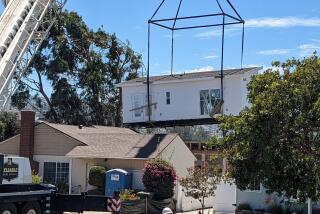Home Lenders Make Push for Cashless Masses
What do you get when you combine a moribund national mortgage market with a federal push to make lending more fair? A plethora of new--and revived--home mortgage products aimed at the hyphenated masses: Low-income, inner-city and first-time home buyers.
The latest in a series of loans introduced or reinvigorated in the past year are those made through the so-called 203k program--a 20-year-old Federal Housing Administration effort that provides low-down-payment mortgages to people who want to buy fixer-uppers.
The program allows borrowers to put as little as 3% down and buy and refurbish low-cost homes. Although 203k loans have been part of the federal housing repertoire for decades, only 619 of these loans were made in all of 1990. This year, the number is expected to exceed 10 times that level with more than 7,500 loans closed, says Ken Crandall, chief architect of single-family development at the Federal Housing Administration.
And thanks to the entry of big national lenders, the program is expected to double in size in 1996 as well, Crandall predicts.
For example, Countrywide Funding Corp., one of the nationâs biggest lenders, recently announced a national push into the 203k market. But other lenders are also actively courting home buyers with modest bank accounts. Over the past year, virtually every big lender in the country has introduced programs designed for people with big dreams and little cash. Now, it is common to find loans that require just 3% to 5% down, for example. Two years ago, 20%-down loans were the standard.
Two factors are spurring the push to urban, minority and first-time home buyers--groups that are often at the widely ignored low end of the housing market.
First, the government has gotten serious about eliminating whatâs believed to be blatant mortgage discrimination. Essentially, white suburbanites have traditionally had a far better chance of getting a mortgage than low-income, inner-city and minority people--despite similar credit ratings and financial prospects. The Clinton Administration and the Department of Housing and Urban Development have been pressuring lenders to change that--and theyâre actively monitoring the industryâs progress.
Meanwhile, lenders are scratching for business. The refinancing boom has gone bust; sales of existing single-family homes are down by double digits since this time last year; total loan figures are expected to drop to $615 billion in 1995 from a peak of $1 trillion in 1993.
*
âEverybody is competing for a share of a shrinking pie,â says David Lereah, chief economist at the Mortgage Bankers Assn. in Washington, D.C. âIf you can identify people who have not been participating in the home-buying process, you can add to your piece of the market.â
The 203k loans are different from other products with low down payments simply because they aim at troubled real estate--houses that need new roofs, paint, floors or even rebuilding to make them livable, Crandall says. With this program, the homeowner can come in with as little as 3% of the purchase price as a down payment. The lender can then finance the remainder of the purchase--and the remodeling--in one loan.
The ability to make the loans pivots on one technical point: how the appraisal is done. Normally, before a loan is made, an appraiser comes in and determines what the house is worth given the current market and current condition. If the sale price is higher than the value of the house, the bank wonât make the loan. Bankers will tell you that appraisals are a problem in âtransitionalâ neighborhoods--particularly with fixer-uppers--because comparable homes are often sold at fire-sale prices.
With the 203k loan, however, the appraised value of the home is based on what it will be worth when the work is done. In some instances, appraisers can even look outside the immediate neighborhood for comparable home sales. This makes it easier to get the loan.
The downside to 203k loans is that theyâre somewhat more expensive than loans for which you make a big down payment. Typically, youâll pay between one and three âpointsâ--one point equates to 1% of the loan amount--in processing and insurance fees above what youâd pay on a loan with a larger down payment. Other than that, the prices generally are competitive.
The other catch is that the program has low loan limits. In Los Angeles, where the median home price is $174,770, for example, the maximum 203k loan is $152,362. And where median housing prices are lower, so are the maximum limits on 203k loans. In Mobile, Ala., its limit is $90,700 for a single-family residence. In Pueblo, Colo., itâs $81,800. In Tampa, Fla., itâs $84,550.
More to Read
Inside the business of entertainment
The Wide Shot brings you news, analysis and insights on everything from streaming wars to production â and what it all means for the future.
You may occasionally receive promotional content from the Los Angeles Times.










